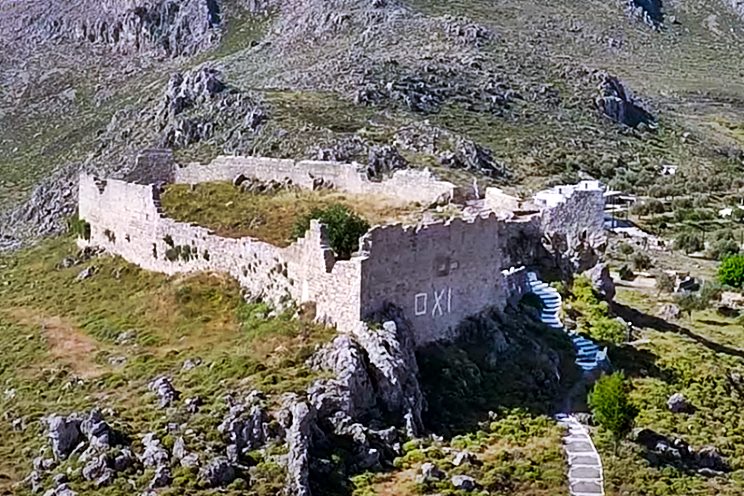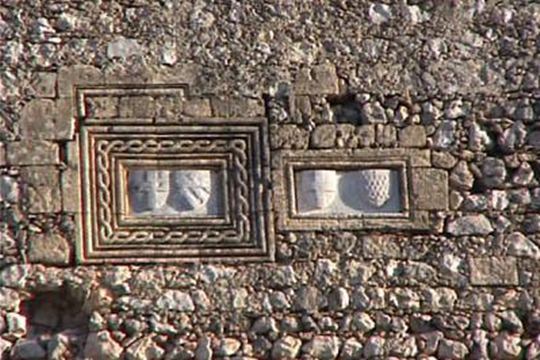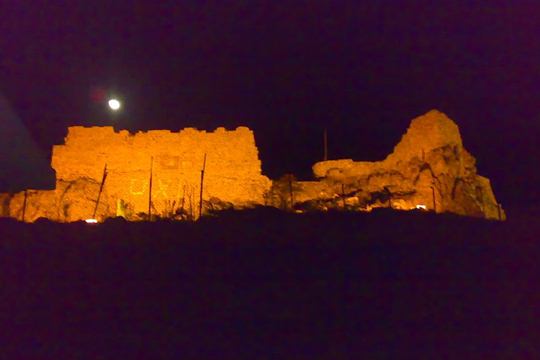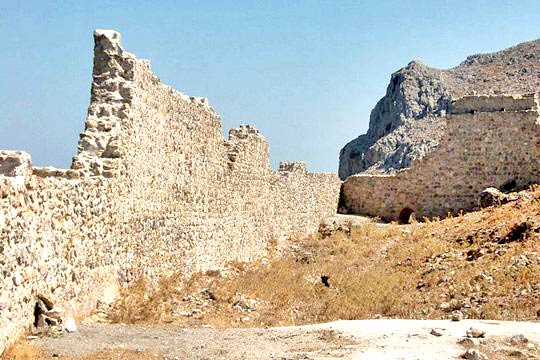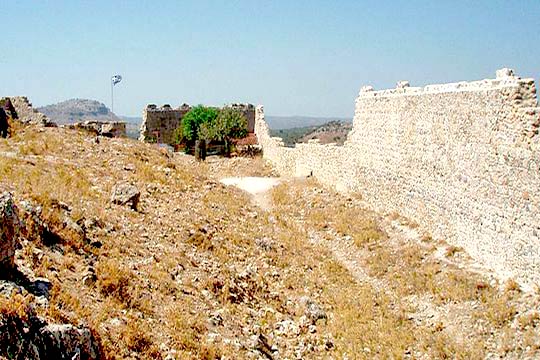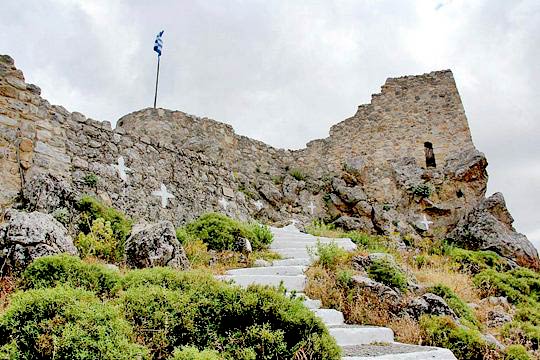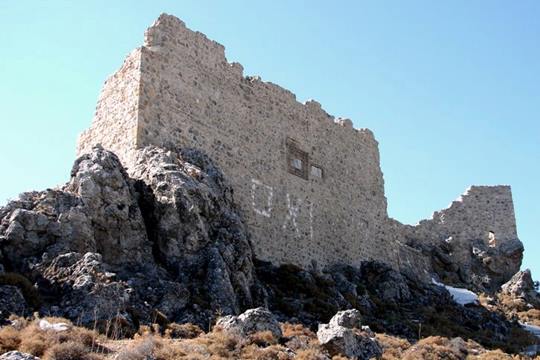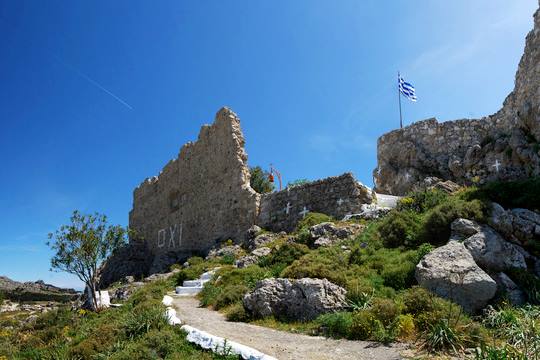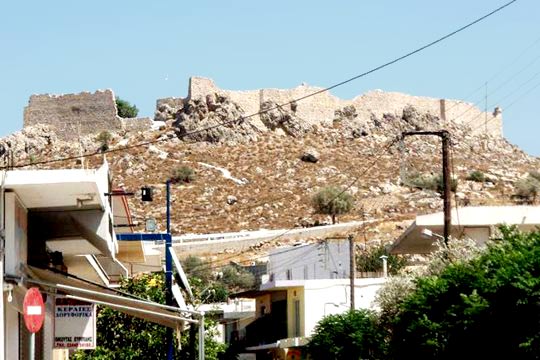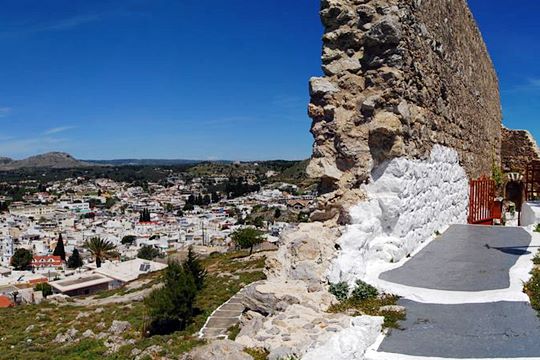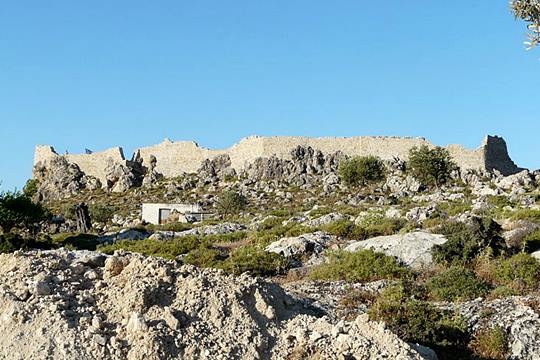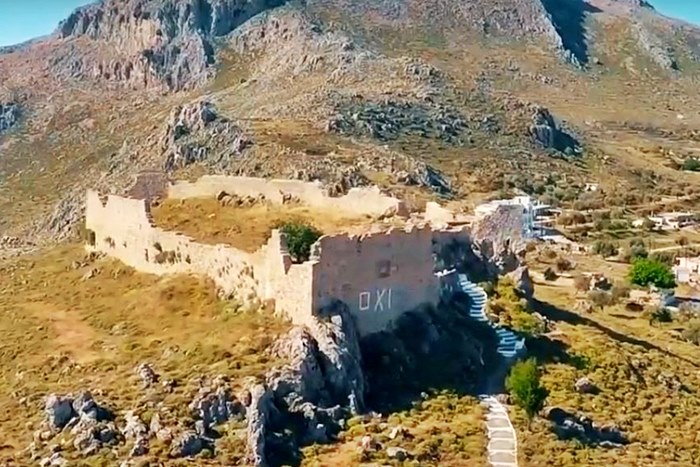Archaggelos, Rhodes, Dodecanese,South Aegean
Castle of Archangelos
| Location: |
| Archaggelos, on the east coast of Rhodes, 27 km from the city of Rhodes |
| Region > Prefecture: | 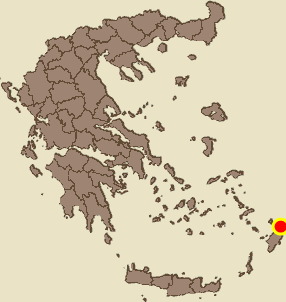 |
| South Aegean Dodecanese | |
| Municipality > Town: | |
| City of Rhodes • Archaggelos | |
| Altitude: | |
| Elevation ≈ 216 m |
| Time of Construction | Origin | |
| before 1457 | IOANNITE |
|
| Castle Type | Condition | |
| Castle |
Average
|
A castle built by the Ioannites on a rock 216m high, 27km south of the city of Rhodes, east of the town Archaggelos, close to the east coast of Rhodes.
Castle Description
Text: Dr. Michael Losse – Singen (Hohentwiel), Germany (17.10.2021)General Description
Archángelos, 2.5 km away from the east coast of the island, is dominated by a castle of the Knights Hospitallers (Order of St. John), which rises on an isolated elongated hill in front of the steep, mighty limestone mountain Profítis Ilías southeast of the town. It is one of the lesser-known castles of the Knights of St. John on Rhodes, but certainly of interest for castle research.
The popular name "Acropolis" – as the castle is even signposted within the village – implies the existence of an ancient fortification, but there are no clear traces of such a building on the castle hill. (“Acropolis” is also what the local population calls the ancient, possibly medieval repurposed fortification about 1.2 km southeast of the castle of Archangelos. It lies on a tongue to the left above the fork of the road coming from Archangelos to Stegna (left) and Agathi Bay.)
From the castle, the rather thin enceinte made of quarry stone with brick developments remained several meters high. Beam holes could have come from a wooden battlement construction. Towers are missing, but the incoming and exiting course of the enceinte’s wall allowed a limited flanking defense, a phenomenon that can often be observed at Byzantine fortifications.
The castle gate was secured by a small barbican (15th century). At the highest point inside the castle there are foundations and walls of (post-)medieval buildings and a turret, which is to be part of the existence of the first construction phase. In the northeastern corner stands a barrel-vaulted chapel, also later changed.
During the Turkish occupation, after 1522, gun-loops are said to have been changed, this was apparently concluded from the findings (cf. Spiteri 2001, p. 137; Poutiers 1989, p. 255). The simple slits topped with rounded ends are at ground level.
The location of the castle offers, among other things, views of the Byzantine fortifications below the monastery of Moni Tsambika, the Atavyros and the vigla near Archipoli.
Access
The castle is signposted via footpaths from the village (note the inscription "Acropolis"). Free access.
History of the castle
It was assumed that there was a Mycenaean fortification and a Byzantine predecessor of the castle of Archangelos, but concrete archaeological findings are missing. The German researcher Albert Berg (1862, p. 113) commented: “Guérin believes that the castle existed before the Ionnites‘ period and was only remedied by them; but this consumsion contradicts the news of [the Order‘s chronicler] Bosio” (German original text: „Guérin glaubt, das Schloss habe schon vor der Johanniterzeit existirt und sei von ihnen nur ausgebessert worden; doch widerspricht diese Vermuthung den Nachrichten des [Ordenschronisten] Bosio“).
Although Berg (1862) claims that the “castle, on high rock [...], was built by the [Knights Hospitallers‘] Grand Master d'Aubusson, after the spot had been devastated by the Turks in 1478 by night raid” (ibid.), the still existing stone-reliefs showing coats of arms testify that the castle is the product of several phases of construction. A diagnosis of its masonry is difficult because of the new grouting carried out a few years ago and partly attached new wall sections. It was thought that the core of the castle could have been a Watchtower, but there is no clear evidence for this.
Several events from the 15th century are known. When a Turkish raid on Archangelos took place in 1457, most of the villagers were taken into slavery and the castle was plundered and destroyed. The Order’s Master Jacques de Milly (r. 1454–61) soon after began an expanding rebuilding, which was continued under the rules of his successors Master Zacosta (r. 1461–67) – his coat of arms stone to the left of the entrance is dated "MCCCCLXVII" (1467) – and Master degli'Orsini (r. 1467–76). A stone-relief showing the coat of arms of the latter is present. The castle thus reached its present extent.
Fragments of the framing of a coat of arms, similar to that of the coat of arms of Zacosta, are recognizable above the degli'Orsinis, i.e. an older coat of arms has been replaced. A coat of arms of degli'Orsini also sits in the western longitudinal wall.
Although Archangelos castle in the 15th century was one of the fortifications that were considered safe enough to accommodate the surrounding population in the event of an attack, the inhabitants of Archangelos were asked in 1479, when war threatened, to seek shelter in Kastro Feraklos near Charaki, a few kilometers away. From this it can be concluded that a distinction had to be made between the short-term retreat to a smaller castle during a raid and prolonged evacuation in the event of war or siege. In 1503 Archangelos was plundered again, now by Turkish corsairs.
After the abandonment of the castle, it was partially demolished to extract stones for new buildings.
Other Info
SourcesBerg, Albert: Die Insel Rhodus, aus eigener Anschauung und nach den vorhandenen Quellen historisch, geographisch, archäologisch, malerisch beschrieben und durch Originalradirungen und Holzschnitte nach eigenen Naturstudien und Zeichnungen illustrirt von Albert Berg. Braunschweig 1862.
Flandin, Eugène [Jean-Baptiste Eugène Napoléon]: Voyage à l'île de Rhodes (Le tour monde, 1862, II9). Paris 1862.
Gerola, Giuseppe: I monumenti medioevali delle 13 Sporadi. In: Annuario Scuola Arch. Atene I, 1914, pp. 319-356.
Kollias, Elias: The castles of the Knights Hospitallers in the Dodecanese Islands. In: Anna Triposkoufi/Amalia Tsitouri (Ed.): Venetians and Knights Hospitallers. Military Architecture Networks (ARCHI-MED Pilot Action) [Hellenic Ministry of Culture, Directorate of Byzantine & Postbyzantine Monuments]. Athens 2002, pp. 165-181.
Losse, Michael: Die Burgen und Festungen des Johanniter-Ritterordens auf Rhódos und in der Ägäis (Griechenland) 1307-1522. (Publisher: Nünnerich-Asmus Verlag) Mainz 2017.
Poutiers, Jean-Christian: Rhodes et ses Chevaliers (1306-1523). Approche historique et archéologique. Imprimerie Catholique sal Araya, Liban 1989.
Spiteri, Stephen C.: Fortresses of the Cross. Hospitaller Military Architecture (1136-1798). Valleta (Malta) 1994.
Spiteri, Stephen C.: Fortresses of the Knights. Ħamrun (Malta) 2001.
Stefanidou, Alexandra: Castles of the Knights Hospitallers. In: Anna Triposkoufi/Amalia Tsitouri (Ed.): Venetians and Knights Hospitallers. Athens 2002, pp. 184-253.
Στεφανίδου, Αλεξάνδρα: Η Μεσαιωνική Ρόδος. Με βάση το χειρόγραφο και την εικονογράφηση του Johannes Hedenborg (1854). / The Medieval Rhodes. Based on the Manuscript and Illustrations of Johannes Hedenborg (1854). 2004.
| First entry in Kastrologos: | March 2013 | Last update of info and text: | October 2021 | Last addition of photo/video: | October 2021 |
Sources
- ΑΡΧΑΙΟΛΟΓΙΚΟ ΔΕΛΤΙΟ, τεύχος 35/Β1 - 1980
- Text and photographs 14,15 (May 2008) & 2,16 (March, 2016) by Dr. Michael Losse
|
|
| Access |
|---|
| Approach to the monument: |
| Archaggelos is 27km from Rodos. The castle is signposted via footpaths from the village (note the inscription "Acropolis"). |
| Entrance: |
| Free access |



